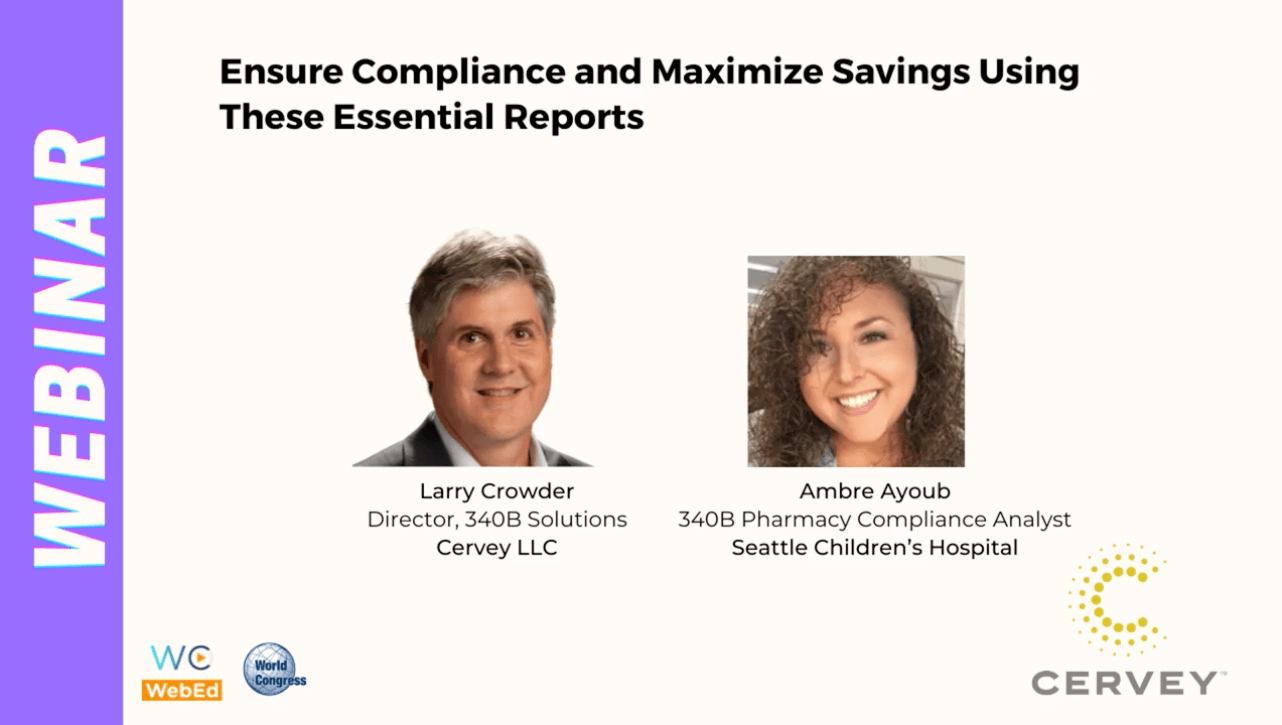
Modern Healthcare Technology Blog

340B Webinar Series - 340B Compliance & Savings: Part 2
In Part 2 of the 340B Webinar Series - 5 Reports to Ensure 340B Compliance and Maximize Savings Larry Crowder, VP of Cervey and Ambre Ayoub, 340B pharmacy compliance analyst with Seattle Children's Hospital are going to cover the first of five 340B reports, the WAC Impact Report (DSH/PED). These five reports are to ensure compliance, maximize savings in the 340B program.
Missed part 1? You can find more info on the NDC or Code Mismatch Report here.

340B Webinar Series - 5 Reports to Ensure 340B Compliance and Maximize Savings: Part 2
Larry Crowder:
We're going to go through these five reports that were mentioned in part 1 that are the most helpful or benefit you the most in being efficient with your program. Then Ambre is to go over how Seattle Children's Hospital implements these reports.
.png?width=1282&name=WAC%20Impact%20Report%20(DSH_PED).png) WAC Impact Report (DSH/PED)
WAC Impact Report (DSH/PED)
Larry Crowder:
Okay, we'll go to the next report, the WAC Impact Report (DSH/PED). If you're a critical access hospital or so community or rural referral center, you don't have the WAC account, but we did put two reports together here. So we have the WAC impact report here that focuses on those accounts that have the GPO prohibition. We don’t want you to lose interest if you're a critical access or sole community, if you don't have the GPO prohibition, you can run a real similar report to this and see what you might be losing out on as far as maximizing your 340B savings by buying a GPO.
So this is a simple way of identifying your WAC purchases that are costing you the most money. And one of the things that we’ve seen is a struggle for covered entities. Sometimes they'll see these items coming in on the WAC invoices, but they don't know what has the biggest impact on their covered entity or on their facility.
.png?width=1266&name=How%20to%20Run%20the%20WAC%20Impact%20Report%20(DSH_PED).png) How to Run the WAC Impact Report (DSH/PED)
How to Run the WAC Impact Report (DSH/PED)
Larry Crowder:
And so what you can do is you can organize the report in a way that puts the biggest losses at the top. And so there are two things you're looking at.
- You're looking at the amount of money lost. To do that, you have to compare what you paid at WAC to GPO because otherwise, you would be GPO.
- And then also the quantity of being bought.
If you see an item that's being purchased at WAC quite often, then that might red flag. You might start asking questions like, why are we buying this at WAC all the time? There are always going to be WAC purchases. You're not going to cut WAC purchases. It's the nature of 340B, but you want to cut the unnecessary WAC purchases. You could do the same thing with the GPO and 340B account, if you're at a non-WAC account or if you don't have the DPO prohibition, but it's the same thing.
What you could do is download the default account monthly purchases. So if you have the DPO prohibition, you would be downloading your WAC purchases.
- You're going to insert the GPO price right next to that WAC cost in a column.
- Next, you're going to multiply the difference of those prices, times the quantity that you bought.
- Lastly, you can sort in the order of your biggest losses for that time period.
WAC Impact Report (DSH/PED) Example
.png?width=1266&name=How%20to%20Run%20the%20WAC%20Impact%20Report%20(DSH_PED).png)
Larry Crowder:
In the example that we’re giving you up here on the little computer screen, you'll see that the top item had the biggest loss, but it was only one. So it may not be something that you could avoid a WAC purchase on, but you see the second item, there were 11 that were bought on WAC in a month's timeframe. So if that's the case, it could be a weekly timeframe. If that's the case, you might want to look at that and make sure that it's accumulating properly, so that the codes are matched correctly.
So whatever's being sent from your EMR system is actually attached to the NDC that you're actually buying, and then make sure that your billing units are correct. Because if your billing units aren't correct, that can also cause you to overbuy at WAC. Ambre, would you like to add anything that you have here as well?
How Often to Run the WAC Impact Report (DSH/PED)
Larry Crowder:
We recommend that this report is run weekly to ensure that accumulations are occurring properly and billing units are accurate.
Ambre Ayoub:
Yeah, certainly. So we do this on a monthly basis because it makes sense for our entity and our invoicing process, but it's exactly like what Larry said. The WAC Impact Report (DSH/PED) helps you understand if your multiplier is accurate, your package size is.
It'll also identify those negative accruals that you might have if you have a lot of negative accruals or even a lot more positive accruals, ensuring that you have clean data. And that the accumulations are proper in the deductions. So we use this also in correlation without with our ABC, that's our wholesaler. We compare our ABC wholesaler invoicing to make sure the deductions, the package sizes are deducted accurately. So we do that report in correlation with this one.
Essential 340B Reporting
Larry Crowder:
That's an important point, Ambre made. Well, there are a couple of things there.
One, your wholesaler is another tool that you have. So you have reports from your wholesaler. And this is certainly if your TPA doesn't have a report that does this for you automatically, you can use your wholesaler reports to see what you purchased on that account, bring in the GPO pricing catalog from your wholesaler, and run this report without even needing a TPA.
That's important to use the tools that you have with you.
The other thing we would say is from time to time, you might find an item that is a non-340B item on this list. So if you're buying something at WAC that's a non-340B item, that's another fix that could be made. If it should be GPO only, for instance, a supply, maybe it's contrast media or anesthesia gases that you've deemed as a non-340B drug, and you're finding it on the WAC report.
That's something that you would find pretty quickly if you were running and managing this report on a consistent basis. So Ambre mentioned she does it month monthly. Some folks do it weekly, but whatever timeframe you choose, you want to be consistent and the report and check and make sure you're not losing anything from purchasing unnecessarily on the lack account or the GPO account.
Ambre Ayoub:
It helps to understand your invoicing process with your entity. And then within your vendors, they make sure that you utilize the tools that your vendors have within their own system. So we would suggest talking to your wholesaler account manager, to see if they have some sort of a soft block system. That's what APC has for us, where we can, we can block a WAC or a 340B purchase so that we can ensure that we do not have diversion issues.
Conclusion
Follow us to stay tuned for Part 2 of the 340B Webinar Series - 5 Reports to Ensure 340B Compliance and Maximize Savings here:
Contact Cervey for a demo of our 340B suite of web-based products that help 340B-eligible healthcare providers with three of their most pressing 340B needs: maximizing savings, ensuring compliance, and optimizing the performance of their contract pharmacies.
Looking for the rest of the webinar series? Check out parts 1, and 3-7 below:
- 340B Webinar Series - 5 Reports to Ensure 340B Compliance and Maximize Savings: Part 1
- 340B Webinar Series - 5 Reports to Ensure 340B Compliance and Maximize Savings: Part 3
- 340B Webinar Series - 5 Reports to Ensure 340B Compliance and Maximize Savings: Part 4
- 340B Webinar Series - 5 Reports to Ensure 340B Compliance and Maximize Savings: Part 5
- 340B Webinar Series - 5 Reports to Ensure 340B Compliance and Maximize Savings: Part 6
- 340B Webinar Series - 5 Reports to Ensure 340B Compliance and Maximize Savings: Part 7
Last Updated: 5/17/2022


